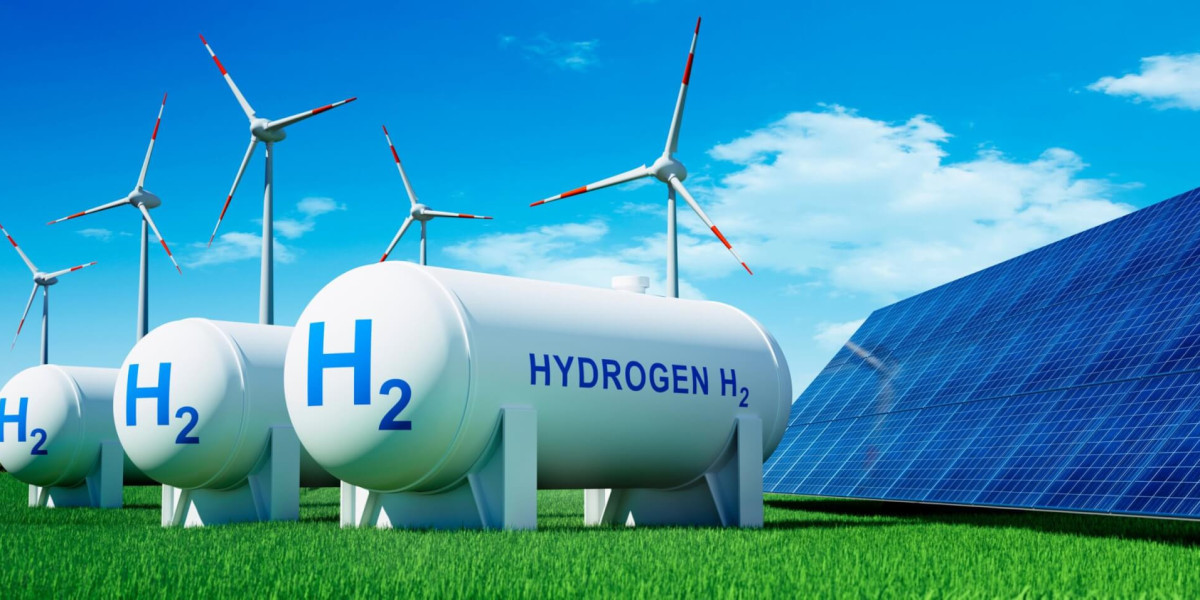The Europe low-carbon hydrogen market is poised for significant growth as the region intensifies its efforts to decarbonize and transition toward more sustainable energy sources. Low-carbon hydrogen, produced with minimal carbon emissions, plays a key role in Europe’s energy strategy, aiming to reduce dependency on fossil fuels and mitigate the impacts of climate change. The European Union’s strong commitment to achieving net-zero emissions by 2050, along with the increasing demand for clean energy solutions, is driving the rapid development and deployment of low-carbon hydrogen technologies. This article explores the dynamics, drivers, challenges, and future prospects of the Europe low-carbon hydrogen market.
What is Low-Carbon Hydrogen?
Low-carbon hydrogen refers to hydrogen produced with minimal carbon emissions during its production process. It is a critical enabler for achieving decarbonization goals in sectors where direct electrification may not be feasible, such as heavy industry, long-haul transportation, and power generation. The hydrogen can be produced using several methods, including electrolysis (powered by renewable energy), natural gas reforming with carbon capture and storage (CCS), and biomass gasification.
Types of Low-Carbon Hydrogen
Green Hydrogen:
Green hydrogen is produced via electrolysis, where water is split into hydrogen and oxygen using electricity generated from renewable sources such as wind, solar, or hydropower. Since no carbon emissions are involved, green hydrogen is considered the most sustainable form of low-carbon hydrogen.
Blue Hydrogen:
Blue hydrogen is produced from natural gas through a process called steam methane reforming (SMR), combined with carbon capture and storage (CCS) technologies to trap the CO2 emissions. While blue hydrogen is not as carbon-neutral as green hydrogen, it is still considered a low-carbon alternative when paired with CCS.
Turquoise Hydrogen:
Turquoise hydrogen is a relatively new method that involves methane pyrolysis to produce hydrogen and solid carbon (carbon black). This process does not release CO2 directly, making it another promising option for low-carbon hydrogen production.
Drivers of the Europe Low-Carbon Hydrogen Market
The Europe low-carbon hydrogen market is being driven by several key factors, including policy support, technological advancements, and the increasing need for energy diversification and decarbonization.
1. Strong Government and Policy Support
Europe has set ambitious climate targets, with the European Green Deal aiming for net-zero greenhouse gas emissions by 2050. The EU has recognized the potential of hydrogen to play a crucial role in achieving these targets. As part of its Hydrogen Strategy for a Climate-Neutral Europe, the EU has committed to scaling up hydrogen production and infrastructure. This strategy outlines plans to increase the production of renewable hydrogen to 10 million tons annually by 2030 and to create a robust hydrogen economy across the region.
Member states like Germany, the UK, and France are also providing significant investments and subsidies for hydrogen projects, including pilot programs, research and development, and large-scale production. These policies have made hydrogen a central part of Europe’s energy transition and are expected to continue driving the market’s growth.
2. Decarbonization of Heavy Industries
Europe’s heavy industries, such as steel, cement, and chemicals, are among the largest emitters of CO2 in the region. Low-carbon hydrogen offers a viable solution to decarbonize these sectors, where electrification is not feasible. For instance, hydrogen can be used as a feedstock in steel production, replacing coal in the blast furnace process, or as a fuel in high-temperature industrial processes. As the EU and other European countries continue to tighten regulations on emissions, the demand for low-carbon hydrogen in industrial applications is expected to increase significantly.
3. Decarbonization of Transport and Mobility
The transportation sector is another major contributor to carbon emissions in Europe. While electric vehicles (EVs) are becoming more popular in light-duty transport, heavy-duty vehicles such as trucks, buses, and trains, as well as marine and aviation transport, are more challenging to electrify. Low-carbon hydrogen can serve as a fuel for hydrogen-powered vehicles, including buses, trucks, and trains, enabling these sectors to reduce their carbon footprint. The development of hydrogen refueling infrastructure and increasing investment in hydrogen-powered transportation solutions is expected to further boost the market.
4. Technological Innovation and Cost Reductions
Advancements in electrolysis technologies, carbon capture and storage (CCS), and methane pyrolysis are driving down the cost of low-carbon hydrogen production. As these technologies become more efficient and cost-effective, low-carbon hydrogen is expected to become more competitive with traditional fossil fuels. The scaling up of hydrogen production, combined with innovations in storage and transportation, will help reduce costs and increase the widespread adoption of hydrogen.
Challenges in the Europe Low-Carbon Hydrogen Market
Despite the promising growth of the low-carbon hydrogen market in Europe, several challenges remain that could slow down its progress.
1. High Production Costs
While the cost of producing green hydrogen through electrolysis has been decreasing, it is still relatively expensive compared to hydrogen produced from fossil fuels (grey hydrogen). The high costs of renewable electricity, electrolysis equipment, and energy-intensive production processes contribute to the price disparity. To make low-carbon hydrogen more commercially viable, significant investments are needed to scale up production and reduce costs.
2. Infrastructure and Distribution Challenges
The development of a hydrogen infrastructure, including pipelines, refueling stations, and storage facilities, is critical for the widespread adoption of low-carbon hydrogen. However, building this infrastructure requires substantial investment and coordination across countries and regions. Many parts of Europe lack the infrastructure to transport and store large quantities of hydrogen, which could limit the availability and accessibility of low-carbon hydrogen in the short term.
3. Regulatory and Market Uncertainties
While European governments are supportive of hydrogen, the regulatory environment remains complex and varies across countries. The establishment of a coherent regulatory framework for hydrogen production, certification, distribution, and usage is still a work in progress. Market uncertainties, including the evolving nature of subsidies, carbon pricing, and trade regulations, may also affect the pace of market development.
4. Environmental Concerns Over Carbon Capture and Storage (CCS)
Blue hydrogen, which relies on natural gas reforming and carbon capture and storage, has raised concerns about the long-term effectiveness and safety of CCS. The ability to capture and store CO2 in large quantities is a key challenge for this production method, and the lack of a widespread CCS infrastructure could limit the growth of blue hydrogen as a solution for decarbonization.
Key Trends in the Europe Low-Carbon Hydrogen Market
Several trends are shaping the future of the low-carbon hydrogen market in Europe, including the transition to renewable energy, partnerships between governments and private companies, and advancements in hydrogen mobility.
1. Growth of Green Hydrogen Projects
Green hydrogen, produced from renewable electricity, is the most sustainable form of low-carbon hydrogen. As Europe continues to expand its renewable energy capacity, the production of green hydrogen is expected to increase. Large-scale green hydrogen projects, such as those being developed in Germany, the Netherlands, and Spain, are expected to become significant contributors to Europe’s hydrogen economy. These projects will play a crucial role in meeting the EU’s ambitious hydrogen production targets.
2. Hydrogen as a Multi-Sectoral Solution
Hydrogen is increasingly being recognized as a versatile energy carrier that can decarbonize multiple sectors, including industry, transportation, and power generation. European countries are focusing on integrating hydrogen across different sectors to maximize its potential. For example, surplus renewable energy from wind or solar farms can be used to produce hydrogen, which can then be stored and used for industrial processes or in transport, creating a flexible and resilient energy system.
3. Hydrogen Mobility and Transport Innovations
The mobility sector is set to benefit significantly from low-carbon hydrogen. Hydrogen-powered vehicles, such as buses, trucks, and trains, are already being tested and deployed in various parts of Europe. Major automotive companies like Toyota, Daimler, and Hyundai are investing heavily in hydrogen-powered transport solutions. The development of hydrogen refueling stations is expanding across Europe, helping to make hydrogen-powered mobility a reality for consumers and businesses alike.
4. Cross-Border Hydrogen Initiatives
Collaboration between European countries and private companies is key to developing a viable hydrogen market. Several cross-border hydrogen initiatives are already in place, such as the European Hydrogen Backbone project, which aims to connect hydrogen production hubs across Europe via pipelines. These collaborations will help create a unified hydrogen market, facilitating the efficient distribution and use of hydrogen throughout the continent.
Competitive Landscape of the Europe Low-Carbon Hydrogen Market
The Europe low-carbon hydrogen market is competitive, with numerous players involved in hydrogen production, technology development, and infrastructure construction. Some of the key companies in the market include:
1. Air Liquide
Air Liquide is a global leader in industrial gases and hydrogen technologies. The company is involved in several green and blue hydrogen projects across Europe, including partnerships with renewable energy producers and industrial players to scale up hydrogen production.
2. Siemens Energy
Siemens Energy is a major player in the low-carbon hydrogen market, focusing on the development of electrolyzers and hydrogen infrastructure. The company is involved in several large-scale green hydrogen projects and provides technologies for hydrogen production, storage, and distribution.
3. Shell
Shell is investing heavily in the hydrogen market, particularly in green hydrogen production from renewable energy. The company has several hydrogen initiatives underway in Europe, including projects focused on integrating hydrogen into its existing fuel infrastructure.
4. Uniper
Uniper is an energy company involved in the production of low-carbon hydrogen through both green and blue hydrogen methods. The company is working on hydrogen production projects in Germany and the Netherlands and is exploring ways to integrate hydrogen into Europe’s energy mix.
Future Outlook of the Europe Low-Carbon Hydrogen Market
The Europe low-carbon hydrogen market is on a growth trajectory, supported by strong policy backing, technological advancements, and the increasing demand for clean energy solutions. While challenges such as high production costs, infrastructure development, and regulatory uncertainties remain, the long-term outlook for the market is positive. As Europe continues to scale up its hydrogen production and expand its hydrogen infrastructure, low-carbon hydrogen will become a key enabler of the region’s transition to a more sustainable, low-emission energy system.
Conclusion
The Europe low-carbon hydrogen market is rapidly evolving, driven by the need for decarbonization across multiple sectors, from industry to transportation. With strong government support, technological innovation, and growing market demand, low-carbon hydrogen is set to play a crucial role in Europe’s energy transition. As the market matures, the challenges surrounding cost, infrastructure, and regulatory frameworks will be addressed, paving the way for hydrogen to become a cornerstone of Europe’s sustainable energy future.
More Trending Reports
Biomass Gasification Market Growth








